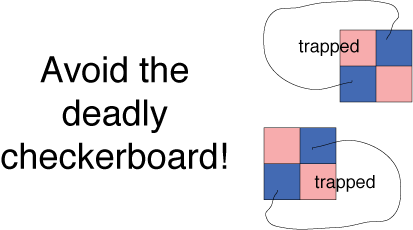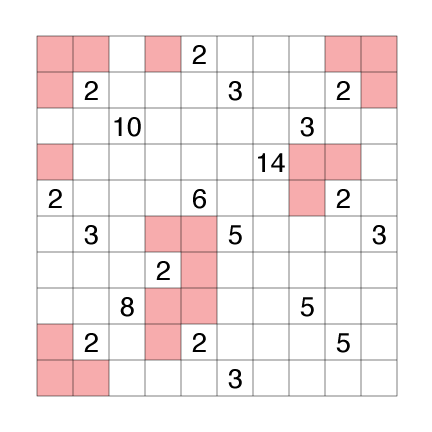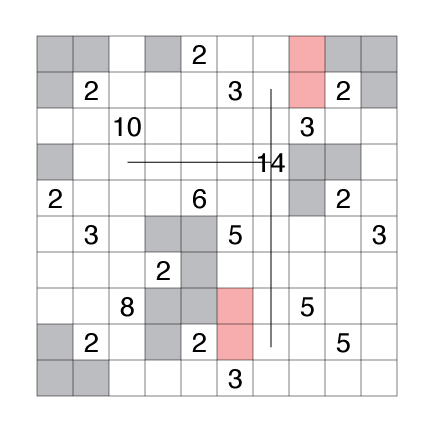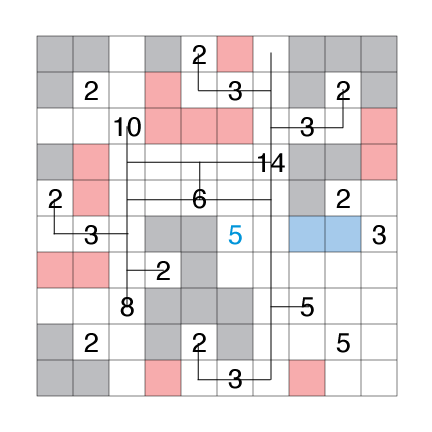Ask Dr. Sudoku #4 – Spelunking 101
Fourth in a series with puzzle solving tips. This time, basic steps to get through Cave puzzles.
While I’ve already written a good description of solving Cave (Corral) puzzles for the USPC, I’ve never drawn up some of the steps for more visual solvers. This week I hope to fix that by highlighting one of the more fundamental logic steps behind these puzzles.
In that post, I mentioned the importance of big/small numbers, and having exit paths for the non-cave cells. And I also brought up what I call the “Anti-Checkerboard” rule, which is a fundamental requirement of the shaded regions to ensure they do not have enclosures. Consider if a 2×2 square had opposite corners inside the cave and outside the cave.

The two cave squares must connect, which can happen somehow around the upper-left, or somehow around the lower-right. Both options will trap one of the pink/non-cave cells. In other words, you can never have a 2×2 checkerboard. So, whenever you have shaded three of the cells in such a square with an in/out/in or out/in/out pattern, you should instantly know how the last of the four is treated.
This is an important rule to apply in the puzzles this week, particularly with diagonally adjacent clues. In the “23” puzzle, for example, every 2 must extend its cave segment towards the diagonally adjacent clue or else strand non-cave cells inside the loop. Just using the anti-checkerboard rule will quickly mark all the cells in pink as not part of the cave.

Then big/small numbers become useful again. The 14 has only 15 cells left, so all but 1 of the cells in each direction can be marked as part of the cave. I like drawing straight lines for the cave as shown in this image. Notice that as the cave extends close to smaller numbers, particularly the 2’s, you learn new cells that cannot be part of the cave.

Continuing farther will get you to about this step.

Here there are two more cave lessons to be learned. First, on the left, you’ll see an 8 and 10 vertically connected. Whenever two numbers are connected but one is larger, there must that many more cells going perpendicular to the connection. In this case, 2 more cells must go left/right from the 10 than from the 8, but with only 2 cells to go there is a single option for the 10/8 pair. This is not very hard to see here, but is important to realize across all cave puzzles which is why I bring it up.
The more interesting deduction is what I’ll call a second-order application of “anti-checkerboard”. Look at the 5 in blue. If it extended to the right into the blue cells, it would mark the first as part of the cave, and the second as outside the cave. It would form a 2×2 checkerboard. So the 5 must go down and not to the right for its last cell. Getting better at catching these situations will speed up your Cave solving times.

Hi motris good walkthrough but i have some doubts…
My brain seems to be stuck on the following points
i)What is an in/out/in or out/in/out pattern?…
ii)How did you paint the following cells as non – cave
A)R6 C5
B)R8 C4
C)R4 C8
Thnks in advance..And i will be using your nice notation of using straight lines for caves from now on ……
In all cases, you’re missing the full implications of “every 2 must extend its cave segment towards the diagonally adjacent clue”. First, the two cells which are edge-adjacent to the 2, but not the other clue, must now be outside the cave, in order to block its line of sight. Then you’ll find you’ve created 3/4 of the dreaded checkerboard, so you must mark the remaining undetermined cell as outside the cave.